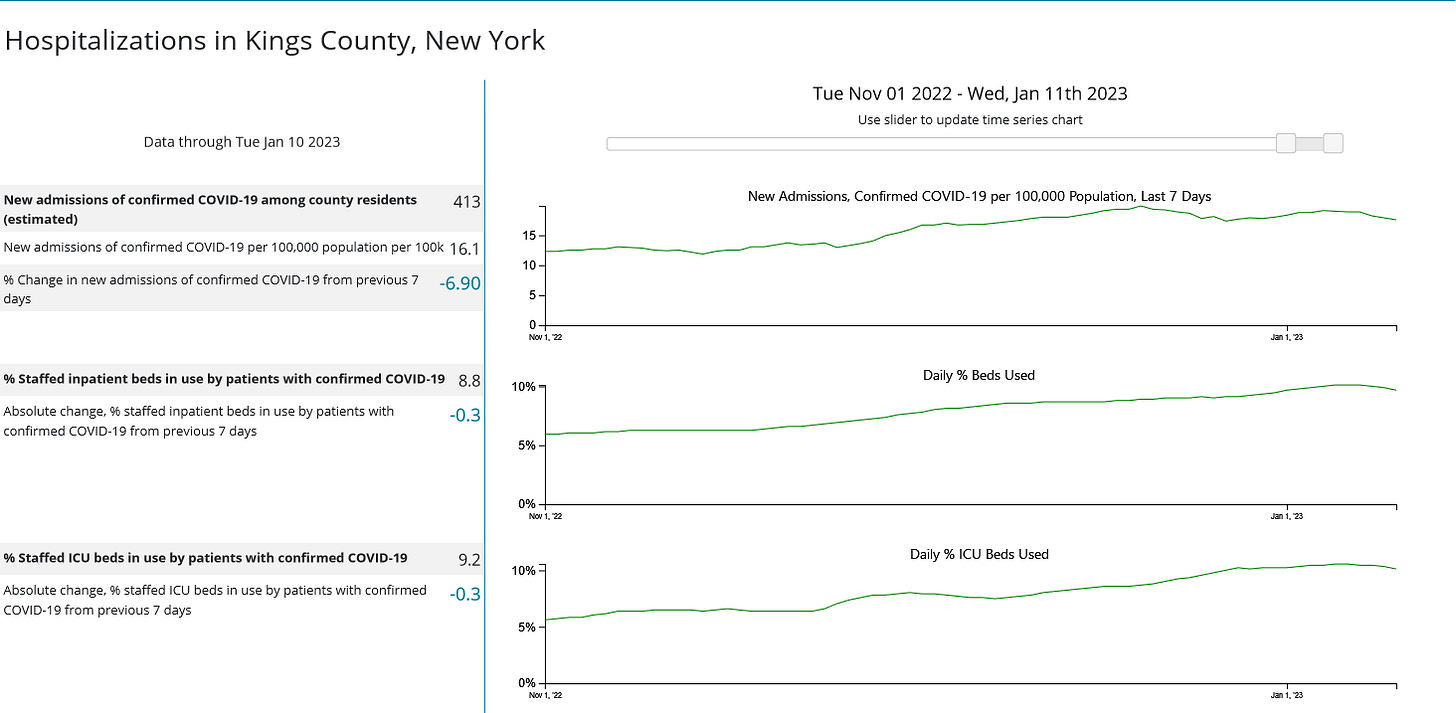Somewhere in its genesis and detection, XBB.1.5, the SARS-CoV-2 strain that is a recombinant Omicron subvariant, acquired a nickname: “the Kraken”.
Yet while the nickname itself summons up the images of a mythic sea monster1, if the medical community is to be believed (a tall order, I realize!), XBB.1.5 got the nicknamed mainly as a goof.
Dr. Ryan Gregory, a biology professor at the University of Guelph in Ontario, Canada, said the nickname was simply "intended to help people keep track of who's who in the ever-growing variant soup."
In a tweet earlier this week, Gregory stressed the nickname was "informal." Previous variants have also been given nicknames like the "nightmare" or "scrabble" variants as the virus continually mutates.
However, given the extent of hysterics and corporate media gaslighting over XBB.1.5, I propose changing its nickname to “Ingrid”.
What better name for a gaslighting virus than the actress whose award-winning turn in the 1944 classic “Gaslight”2 gave us the term as a synonym for “deceive”?
According to Ryan Gregory, a professor of biology at the University of Guelph in Ontario, Canada, the nickname is little more than nerdy doctor playfulness.
Yet the presumed nerd provenance of the nickname has not stopped corporate media from latching onto the mythic and almost Jungian connotations suggesting monstrous evil.
NBC Chicago has Cook County “bracing” for the variant’s onslaught.
The new and highly contagious COVID variant known as XBB.1.5, or informally as the "kraken" variant, quickly rose to dominance in the Northeast, but experts in the Chicago area are bracing for a similar situation to unfold here soon.
In an earlier article, NBC Chicago highlighted the strain’s rise as a percentage of confirmed cases, while describing “experts” as expecting a “surge”.
In the Midwest, XBB.1.5 also rose in numbers to 7.3%, up from 6% of cases last week, CDC data showed.
Despite the change in estimates, the variant continues to be the only current omicron subvariant showing significant growth in recent weeks as experts say it is the most contagious variant yet.
That same article also provides an excellent example of “burying the lede” by pointing out the lack of hospitalizations associated with the virus nearer to the article’s end."
Dr. Allison Arwady, commissioner of the Chicago Department of Public Health, said Tuesday that she anticipates numbers in the Midwest will continue to rise. She noted last week the variant is "clearly more infectious" than other variants, "meaning it's spreading more easily" and "outcompeting the other variants."
"I'm expecting to see some increase in cases," she said during a Facebook Live Tuesday. "New York is not getting overwhelmed with hospitalizations, which is great. They are up, not surprisingly, because cases are up, but again, we have tools, we have vaccines, we have treatments that can that can help keep this hopefully under control. So it wouldn't surprise me to see an increase in cases. It also wouldn't surprise me if we move from that medium to that high level. You know, I would love it if we didn't get there, but I am not anticipating, based on this variant, you know, the major surge where you're talking mask mandates or, you know, like when omicron first got here."
An essay in “The Conversation” explicitly associated the variant with the mythic sea monster.
The latest variant to worry health professionals and virologists alike is XBB.1.5, nicknamed “kraken” by a group of scientists that has been naming new variants after mythological creatures to make the virus’ evolution more accessible to the public. Here’s what we know about it.
Medical Xpress called the variant the “most transmissible” strain yet.
The Omicron subvariant XBB.1.5, the most transmissible COVID-19 subvariant so far, is spreading quickly across the United States and was predicted on Friday to become Europe's dominant strain in a matter of weeks.
Later in the article, the authors also connected the variant to the sea monster.
Dr. Gregory’s outwardly innocuous explanation of the nickname aside, corporate media definitely wants the public to be thinking COVID thoughts built around terrifying sea creatures.
USA Today described the variant’s entry in to Arizona by calling the strain “crazy infectious.”
The not-so-good news is that XBB.1.5 is really contagious, or as University of Southern California virologist Paula Cannon recently told USA Today, it's "crazy infectious." World Health Organization officials on Jan. 4 said XBB.1.5 had been detected in 29 countries and is "the most transmissible subvariant that has been detected yet."
The El Paso Times went from reporting the detection of XBB.1.5 within the county limits straight into a warning that people needed to get the demonstrably toxic and provably useless mRNA inoculations and boosters on board.
The new COVID-19 omicron variant XBB.1.5 has been identified in the El Paso community. City health officials are encouraging residents to continue practicing safety protocols as the new variant is currently the country’s fastest-spreading coronavirus subvariant.
Yet what the El Paso Times completely omitted was any discussion of hospitalization and mortality trends in El Paso County, Texas—with good reason: cases are on the decline in El Paso, and mortality is virtually nonexistent.
Hospitalizations there are also trending down.
The mythic monster of a virus is making the residents of El Paso County less sick. Oh, the humanity…!
While XBB.1.5 is present in the county, and becoming more widespread, it has been in that part of the country for some time and is still behind BQ.1.1, according to the CDC’s latest nowcast.
Similarly, in Maricopa County, Arizona, hospitalizations have been trending down since early December.
Somewhat anomalously, cases and deaths are on the rise there, but still low relative to past outbreak cycles.
Moreover, in that part of the US (HHS Region 9), XBB.1.5 is behind both BQ.1 and BQ.1.1.
Even in Cook County, Illinois, where doctors are “bracing” for a “surge” of XBB.1.5, the strain only accounts for ~14% of cases.
Hospitalizations are also down in and around Chicago.
In another anomalous turn, cases are down, but there is a distinct rise in deaths.
Even Michigan which is in the same HHS region as Illinois and where corporate media thinks XBB.1.5 will simply “sweep” over the state, cases and deaths only recently began trending up, after declining through much of November and December.
It also comes as no surprise to hear of a declining hospitalization trend in Michigan.
This is hardly the stuff of pandemic paranoia, no matter how hard corporate media tries to promote otherwise. A viral “surge” that makes people less sick is hardly a public health crisis, or even a personal health concern for the average healthy (no comorbidities) individual.
Where XBB.1.5 is causing a bit of a stir is in Massachusetts. There, in HHS Region 1, XBB.1.5 accounts for 81.7% of cases.
Yet in Suffolk County, Massachusetts (Boston), while cases are up, deaths are nonexistent.
Even with the XBB.1.5 “surge”, new hospital admissions are down.
Cases are also down in Kings County, New York (part of New York City), which is in the other HHS Region (HHS Region 2) with a major surge of XBB.1.5.
Hospitalizations are similarly down.
An odd turn of events for a presumably highly transmissible and quite dominant SARS-CoV-2 variant.
Even where XBB.1.5 dominates, it is not sending people to hospital.
The essence of gaslighting is to weave a tale of half-truths, sprinkled only sparingly with outright lies. Omissions do more to shape a narrative than admissions do. By reporting on relative case percentages and only mentioning hospitalization at the very end of a story—the part of a news article least likely to be read—corporate media can spin the data on XBB.1.5 to make it appear a grave threat, whereas evaluating the data in full context gives a more problematic assessment.
Much like Ingrid Bergman’s husband in the 1944 classic, corporate media spins a tale of pandemic pandemonium, urging the public to believe COVID-19 is a major public health crisis the world over, when the data clearly and unambiguously show that it is no such thing (with the obvious caveat for China, where no good data seems to exist). The seeming dangers of XBB.1.5 are the rationale for promoting and propagandizing the toxic and ineffective mRNA inoculations as the only defense against the ravages of COVID-19 and XBB.1.5.
And just like Ingrid Bergman’s character herself, people can defeat this corporate media gaslighting by focusing on the facts—on the hard data—and only using narrative to organize that data into something coherent.
XBB.1.5 is a variant of the SARS-CoV-2 virus. That makes it an infectious respiratory pathogen capable of causing Influenza-Like Illness (ILI) of varying severity. Like most infectious respiratory pathogens, it will make some people very will, will make some other people very dead, but it appears to be making the majority of people even in New York and Massachusetts only somewhat ill if even that.
People by and large survive the common cold. People by and large survive seasonal flu. People will by and large survive COVID-19. People have already survived COVID-19, and the emergence of XBB.1.5 does not alter that reality in the slightest.
Corporate media hopes you will forget that reality and embrace the fiction of their Pandemic Panic Narrative. To that end, they will continue to gaslight everyone, as they have gaslit everyone since the emergence of the original Wuhan strain.
Do not trust the narrative. Verify then follow the data instead.
The Kraken is a mythic Scandinavian sea monster, possibly based on sightings of actual giant squid, and has been a source of inspiration for a number of writers and poets such as Alfred, Lord Tennyson.
https://www.britannica.com/topic/kraken
Ingrid Bergman won an Academy Award for her performance in 1944’s “Gaslight”, a psychological thriller about a woman whose husband, exquisitely played by Charles Boyer, tries to make her think she’s insane by means of deception and subterfuge, much like corporate media tries to make the public paranoid about the XBB.1.5 subvariant.
https://www.imdb.com/title/tt0036855/






















If people are so easily fooled by the nicknaming of a virus to infer something with respect to its deadliness then we are in serious trouble. This is the problem with how information is disseminated. Because all of these variants are now seeming to blend together they had to find a way to make it more distinct in the public's ignorant eyes, which is to call it some so evil and ominous!
This is just par for the course when it comes to the media. Catastrophize and analogize rather than actually science...ize...
Gregory's claim is disingenuous. Of all the names to use, do you mean to tell me they settled on a violent mythic sea monster that kills? Whatever, you say Mutumbo.
It smells like someone in the behavioural scenic department got a hold of someone in the virology department and had a chat. I think they knew damn well what they were doing when they settled on Kraken. It was chosen to mess with people to keep them in fear.
And this mask thing. This has to be killed somehow. It's not an innocuous response anymore. This now falls into faith in pseudoscience. The problem with pushing masks so hard is they base policy on junk science.
A comment from his Twitter feed:
"Jan 10
Replying to
@TRyanGregory
I couldn't take it more seriously. My first infection 5 weeks ago was very mild, but I'm determined not to do it again. I'm so mad at myself for contracting Covid."
These people believe they can avoid and avert an endemic respiratory illness. That's because the 'experts' keep saying 'Covid is still out there' conflating it with it still being a 'pandemic'. So people miscalculate this believing they can - dodge, duck dip, dive and dodge - until the 'The Experts (TM)' declare the pandemic 'over'. Which they never will.
The 'experts' have lead people astray.